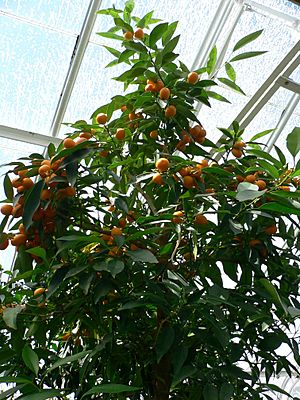Clymenia (plant) facts for kids
Quick facts for kids Clymenia (plant) |
|
|---|---|
 |
|
| Scientific classification |
|
| Kingdom: | Plantae |
| Clade: | Tracheophytes |
| Clade: | Angiosperms |
| Clade: | Eudicots |
| Clade: | Rosids |
| Order: | Sapindales |
| Family: | Rutaceae |
| Subfamily: | Aurantioideae |
| Genus: | Clymenia Swingle & Tanaka. |
| Species | |
Clymenia is a small group of flowering plants that belong to the Rutaceae family, which is also known as the citrus family. There are only two known types, or species, of Clymenia. Many scientists often include Clymenia within the larger group of Citrus plants, like oranges and lemons.
Contents
What is Clymenia?
Clymenia plants grow as a shrub (a bushy plant smaller than a tree) or a small tree. Unlike many citrus plants, they don't have thorns or spines. Their leaves have a short, narrow stem connecting them to the branch. This is a special feature that helps tell them apart from most other citrus plants, especially those called papedas that grow in the same areas.
Clymenia Fruit
The fruit of the Clymenia plant is small and looks very much like a tiny citrus fruit. It tastes sweet and a bit like lemon. These tangerine-sized fruits have many sections inside, with yellow flesh. They have a tough, leathery skin, just like a true citrus fruit. Inside, they contain many seeds. People on the Bismarck islands eat these fruits. They call them a-mulis.
Where Clymenia Grows
Clymenia plants are native to only a few places. These include Papua New Guinea and some nearby small islands. You can find them on New Ireland, New Britain, and the Admiralty Islands. Clymenia needs a very warm, tropical climate. It is much harder to grow than other citrus plants. Even in warmer parts of the United States, it can usually only grow in a greenhouse. Plants that grew well in greenhouses in Riverside, California, died when they were planted outside in the dry weather. Local villages grow Clymenia for their own use, but it has never been grown on a large farm for sale.
How Scientists Classify Clymenia
People on some islands in the southwestern Pacific Ocean have grown Clymenia for its sweet fruits for a long time. At first, scientists thought Clymenia was a strange citrus hybrid. A hybrid is a plant that is a mix of two different types of plants.
Early Ideas About Clymenia
A botanist (a plant scientist) named Tyôzaburô Tanaka noticed that Clymenia could mix with a few other citrus plants, like kumquats. However, he also saw that Clymenia looked very different from other citrus plants in many ways. Another botanist, Walter Tennyson Swingle, suggested that Clymenia should be its own separate group, or genus. He did this in 1939. He named it after Clymene, a princess from ancient Greek stories. Swingle thought that Clymenia and citrus plants came from the same ancient ancestor. In 2000, another scientist named Berhow thought that Clymenia might be closely related to kumquats. He wondered if it could be a Citrofortunella, which is a hybrid of a kumquat and another citrus.
New Discoveries
More recently, scientists have studied the DNA of Clymenia. This has helped them understand its family tree better. They found that Clymenia polyandra is a "pure" species. This means it is not a hybrid of a kumquat and another plant. Scientists also found that Clymenia fits within the larger Citrus group. It is very similar to the Australian and New Guinean limes. These limes used to be in their own groups, but now they are considered part of Citrus.
Because of these new findings, scientists now think Clymenia should also be part of the Citrus group. If Clymenia were kept separate, the Citrus group would be "paraphyletic." This means the group would not include all the descendants of a common ancestor. So, Clymenia species might be considered a subgenus (a smaller group within a genus) of Citrus. In 2021, a new classification of the Rutaceae family included Clymenia within the Citrus genus.
Species
The two species included in the genus are:
- Clymenia platypoda B.C.Stone
- Clymenia polyandra (Tanaka) Swingle
See also
 In Spanish: Clymenia para niños
In Spanish: Clymenia para niños

